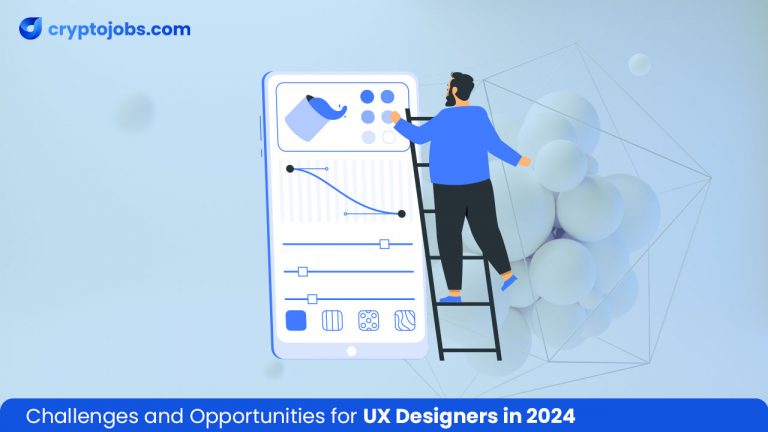
Challenges and Opportunities for UX Designers in 2024
- cryptojobs.com
- February 13, 2024
- All Posts, Blockchain
- 0 Comments
2024 arrived amidst a major technological upheaval. The rapid integration of blockchain technology has greatly transformed the way people interact with and do business. The changing user expectations present both opportunities and challenges for UX designers. As these professionals are the architects behind digital interfaces, the shift has opened doors to new roles such as blockchain UX designer and crypto UX designer. On the other hand, a UX designer also has to keep up with the changing technology to design interfaces that are engaging and enriching for the user.
In this article, we have listed the challenges and opportunities that define the path forward for UX designers in 2024. The aim is to provide insights that empower professionals and businesses to thrive in the ever-evolving realm of user-centric design.
Rapid Technological Advancements
In 2024, the rapid pace of technological advancements presents both a challenge and an opportunity for UX designers. On one hand, emerging technologies such as Artificial Intelligence (AI), Augmented Reality (AR), and Virtual Reality (VR) open new possibilities for creating immersive and engaging user experiences.
For a UX designer, the opportunity lies in harnessing these technologies to enhance user interactions and streamline workflows. AI-powered chatbots can provide personalized assistance, AR and VR can offer immersive product experiences, and machine learning algorithms can optimize user interfaces based on individual preferences. Embracing these innovations empowers designers to create cutting-edge experiences that captivate and delight users.
You may like our Blog: Top 7 Tips for a Graphic Designer to Switch to Blockchain industry
At the same time, the challenge lies in ensuring that technological advancements do not overshadow the core principles of user-centric design. Designers must strike a balance between innovation and usability, ensuring that new technologies enhance rather than detract from the user experience.
Evolving User Expectations
Within the fast-paced digital landscape, users’ expectations are also quickly evolving. They now expect seamless, intuitive interactions tailored to their individual preferences. This presents a challenge for UX designers as they have to strike the delicate balance between delivering personalized content and maintaining intuitive design principles.
Catering to personalized experiences requires UX designers to harness emerging technologies. Crypto UX designers, for example, may need to integrate blockchain technology to ensure secure and transparent personalization mechanisms within digital wallets or trading platforms. Similarly, blockchain UX designers must leverage decentralized technologies to provide users with control over their data.
The opportunity lies in leveraging these evolving user expectations to drive innovation and differentiation. By understanding and anticipating user needs, UX designers can create immersive experiences that not only meet but exceed user expectations. For instance, implementing predictive analytics algorithms can anticipate user preferences in crypto wallets, offering seamless transaction suggestions based on past behavior.
Accessible and Inclusive Design
The concepts of accessibility and inclusiveness are not new in UX design. However, integrating them into the burgeoning field of crypto and blockchain requires a thoughtful approach. The diverse needs of users, including those with disabilities, demand meticulous attention to detail and adherence to accessibility standards. Designing interfaces that cater to a wide range of users, including those with visual, auditory, or motor impairments, poses significant challenges in terms of ensuring usability and compliance with accessibility guidelines.
That being said, by prioritizing accessibility and inclusive design principles, a UX designer can create digital experiences that accommodate diverse user needs and foster inclusivity and equity within the crypto and blockchain space. Embracing inclusive design not only enhances the user experience for all users but also reflects positively on the brand’s commitment to diversity and social responsibility.
For crypto and blockchain UX designers specifically, the opportunity to pioneer inclusive design practices within this rapidly evolving industry presents a unique chance. By designing inclusive and accessible interfaces, UX designers can contribute to the democratization of blockchain technology and foster broader adoption among diverse user groups.
Data Privacy Concerns
In UX design, data privacy concerns present a delicate balance between delivering personalized experiences and upholding user trust. With increasing awareness of data breaches and privacy violations, users are becoming more cautious about sharing their personal information. As UX designers strive to deliver personalized experiences, they must navigate this delicate balance.
For crypto UX designers and blockchain UX designers, this challenge is particularly pronounced. Such applications often involve sensitive financial transactions and personal data, so ensuring robust data privacy measures is imperative. Designers must implement privacy-enhancing technologies, such as zero-knowledge proofs and decentralized identity solutions, to safeguard user data while delivering personalized experiences.
Amidst these challenges lies the opportunity for UX designers to establish trust through transparent and user-centric data practices. By adopting principles of privacy by design and providing clear explanations of data usage and storage practices, designers can foster a sense of transparency and accountability. This not only enhances user trust but also strengthens the brand reputation of crypto and blockchain applications as secure and trustworthy platforms.
Cross-Platform Consistency
The abundance of digital platforms and devices is another thing that UX designers have to worry about. The challenge lies in designing cohesive and seamless experiences across diverse digital ecosystems, including web, mobile, desktop, and emerging platforms such as wearables and smart home devices. Each platform comes with its unique constraints, screen sizes, and interaction patterns, making it daunting for designers to maintain consistency while catering to varied user needs and contexts.
For UX designers specializing in crypto and blockchain applications, this challenge is further compounded by the unique characteristics of these platforms. Crypto UX designers must navigate the intricacies of blockchain technology while blockchain UX designers grapple with integrating complex decentralized systems into user-friendly interfaces.
Achieving consistency across platforms becomes not only a technical challenge but also a strategic move in fostering user trust and engagement. It also presents the opportunity for UX designers to innovate. By embracing cross-platform design principles and leveraging adaptive design techniques, designers can create cohesive experiences that seamlessly transition across devices and platforms. Plus, the evolving nature of blockchain technology offers fertile ground for experimentation and innovation, providing UX designers with the chance to pioneer novel solutions that set industry standards.
You may like to know How Much Does a UI/UX Designer Earn
Wrapping Up
Despite their formidability, these challenges also serve as catalysts for innovation and differentiation. By embracing the dual role of problem-solvers and visionaries, UX designers have the opportunity to shape the future of digital experiences. As we forge ahead into 2024 and beyond, let’s seize these challenges as opportunities for growth, exploration, and collaboration.
Finding a job in Web3 space can be stress-free with cryptojobs.com, as the platform is trusted by top Web3 and crypto companies for hiring the best talent. Start your job search today and find a position that matches your skillset.




